For those of you interested in the hydro-morphological ancestry of today’s American landscape, here – for starters – is an absolutely amazing map of ancient Mississippi riverbeds:

(Originally spotted at Pruned.)
Architectural Conjecture | Urban Speculation | Landscape Futures
For those of you interested in the hydro-morphological ancestry of today’s American landscape, here – for starters – is an absolutely amazing map of ancient Mississippi riverbeds:

(Originally spotted at Pruned.)
“It’s hard to miss,” says the Montreal Mirror.

“Stroll west along Montreal’s Old Port from St-Laurent and you’ll see it standing defiant like a 45-metre, steel-reinforced middle finger in the face of the surrounding gentrification. Abandoned in 1996, Silo #5 has received a new lease on life thanks to two young Montreal-based artists known as [The User]. Using strategically placed loudspeakers, microphones, next-level telecommunications technology and the building’s 22 seconds of natural reverb, Thomas McIntosh and Emmanuel Madan converted the Silo into a giant interactive sound installation, playable from anywhere with a good Internet connection.”

Now known as the Silophone, it “combines sound, architecture, and communication technologies” – another way of saying that it’s architecture you play by phone. (Incidentally, Thomas McIntosh – one half of [The User] – studied -yes- architecture).
As NPR’s “All Things Considered” describes it, McIntosh and Madan “channel sounds via phone and the Internet into the silo. Sounds bounce around the Silophone… and a microphone picks up the echoes and returns them to the listener. (…) The silo’s chambers reach up to 10 stories high and have an impressive reverberation time of more than 20 seconds. Even simple sounds are transformed into something completely different.”
This not only architecturalizes the North American phone system in an interesting way, but it telephonizes Quebecois architecture.
NPR continues: “Silo #5 was built in 1958 and has been called a masterpiece of modern architecture. The building has three separate sections, joined together by elevated corridors.”

And now it’s a musical instrument.
Meanwhile, in a recent post on BLDGBLOG, the BBC program *Coast* was cited – but you may or may not have noticed that the website for that show’s first episode featured something called “sound mirrors”:

“These three concrete ‘listening ears’ range in size from 20 to 200 feet in size. They were built between World War I and II: designed to give early warning of incoming enemy aircraft.” While not able to be played by phone, as it were, the Kentish sound mirrors very clearly relate to the topic of resonance as an architectural phenomenon – about which I hope to post again soon.
It would be interesting to consider, meanwhile, whether it’s possible to build a structure like the Montreal Silophone, but with an extraordinarily long internal resonance period.
1) You could say something, for instance, and let it echo round, feedbacking and folding into itself through curtains of reverb – until your mate comes by the next day, records the noises, filters it somehow, writes down what you said and there you go: it’s the world’s most labor-intensive intercom system. Conversations on time-delay.
2) You could build it on a particularly windy area of the Canadian shield –

– and you could pierce the outer walls with windows attached to small alcoves attached to small doors in such an exact way that the wind, at every moment of the day, is always playing certain notes. By the time the notes have stopped resonating, maybe two or three days later, maybe even two or three weeks, more wind has come along and the tower is never silent. Certain storms have certain sonic signatures.
3) To torture bats you could release them into the silo in an extreme gale and then – [censored by the ASPCA] –
Finally, if you like abstract electronic music inspired by architecture, check out this CD by Savvas Ysatis and Taylor Deupree. And, since the company that put this CD out appears to have gone bankrupt (?), any budding entrepreneurial types out there reading BLDGBLOG surrounded by heaps of Benjamins who might want to start a music label dedicated to architectural phenomena – *Soundtracks for Architecture* – give me a shout…
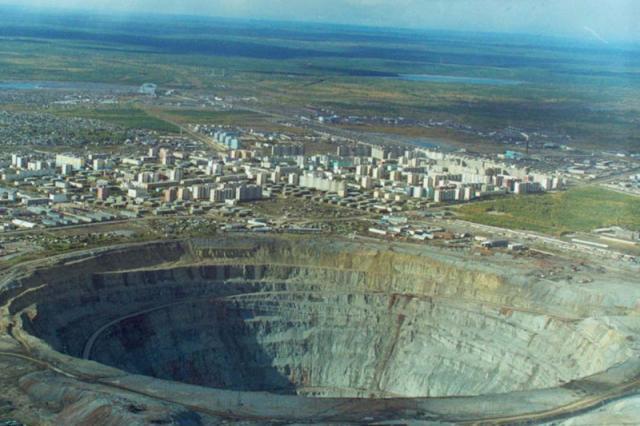 [Image: The Mirny diamond mine; photographer unknown].
[Image: The Mirny diamond mine; photographer unknown].
This diamond mine in eastern Siberia (Mirny, to be exact) is so deep that the surrounding “air zone… is closed for helicopters” after “a few accidents when they were ‘sucked in’ by downward air flow…”
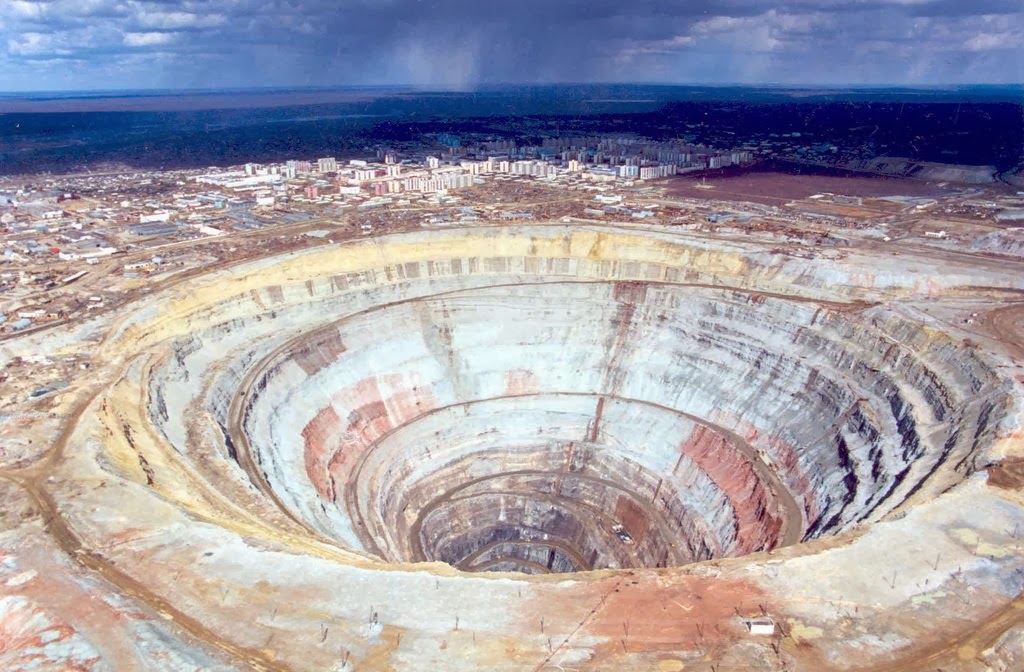
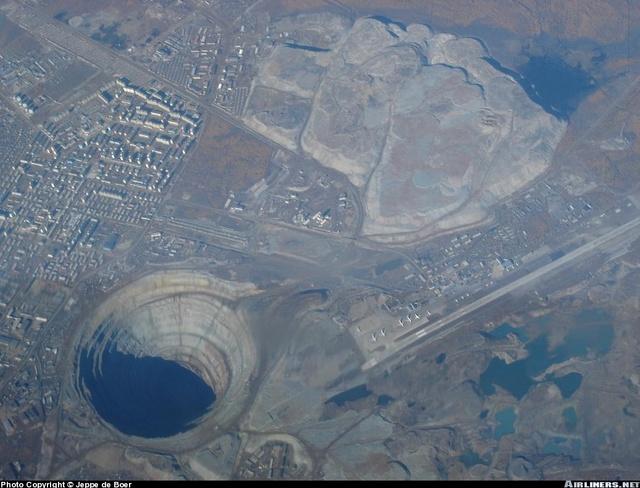
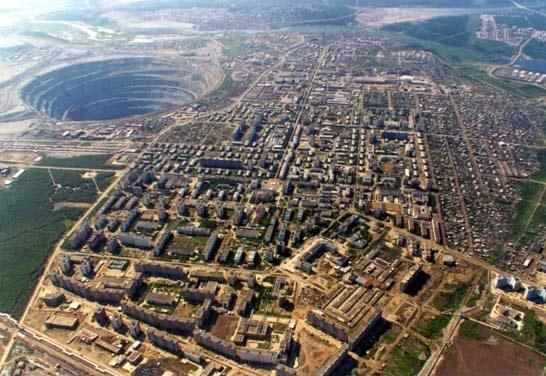 [Images: Mirny diamond mine; photographers unknown].
[Images: Mirny diamond mine; photographers unknown].
Look for the tiny red arrow in the following photograph; it’s pointing to a 220-ton rock-hauling truck more than 20′ tall.
 [Image: The Mirny diamond mine; photographer unknown].
[Image: The Mirny diamond mine; photographer unknown].
Thanks to Javier Arbona for both the link and photos.
Meanwhile, something altogether different and Jules Vernian is about to occur thanks to some Japanese scientists hoping to drill down into the earth’s mantle: “Using a giant drill ship launched [in July 2005], the researchers aim to be the first to punch a hole through the rocky crust that covers our planet and to reach the mantle below.”
Then, in an oddly Borgesian—or perhaps MC Escherian—moment of nomenclatural mise-en-abîme, “The 57,500-tonne drill ship Chikyu (Japanese for Earth) is being prepared in the southern port of Nagasaki. Two-thirds the length of the Titanic, it is fitted with technology borrowed from the oil industry that will allow it to bore through 7,000 metres of crust below the seabed while floating in 2,500 metres of water—requiring a drill pipe 25 times the height of the Empire State building.”
Let’s repeat that: the drill-ship is called Earth and it is drilling down into the Earth… The attack of the simulacra begins.
[See also: Mirny Mine, pt. 2 and Bingham Pit, Utah].
In an interesting post on Design Observer, William Drenttel looks at disaster-preparedness exercises in Manhattan and West Virginia, in which fake catastrophes are role-played in otherwise everyday landscapes.

His post brings to mind an older exhibition at the Center for Land Use Interpretation (CLUI) in Los Angeles, which extended this analysis into a look at law enforcement training architecture—that is, totally abstract American “towns” where police, SWAT teams, FBI agents, fire crews, etc., can storm buildings, kick down doors, set up temporary command posts, and more.
That exhibition, called “Emergency State: First Responder and Law Enforcement Training Architecture” is totally fascinating, and well worth taking a look at. What’s particularly interesting is that these training villages, built to look as abstract and everyday as possible (complete with fake Starbucks, fake ATMs, fake drive-thrus), as if they are the absolute value of nowhere, actually just look like the United States.
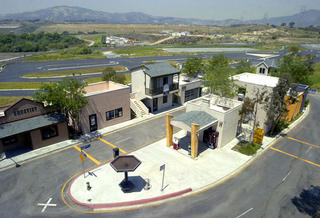
That is, of course, their point. “Condensed simulacrum of our existing urban environments are forming within our communities,” CLUI writes, “where the first responders to emergencies, on a small or large scale, practice their craft of dealing with disaster.” Or, using a more Ballardian vocabulary, “Whether they are made for police or fire departments, these training sites are stylized versions of ordinary places, with the extraordinary horrors of the anticipated future applied to them on a routine basis.”
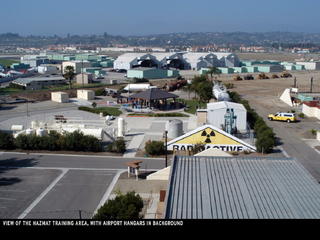
This opens up the somewhat more intellectually vertiginous implication that the United States already is a training landscape, militarized in advance and gridded for a surveillant centralization of control.

Susan Willis here comes to mind as someone writing about the strange, even uncanny, topology formed by America’s everyday national landscape and its overlapping, militarized simulation. “Operation Robin Sage,” in the pinelands of North Carolina, for instance, was a military training exercise that involves unwitting civilians and “real” streets and buildings for its successful execution:
Staged over a period of weeks, [Operation Robin Sage’s] scenes and acts occurring randomly across a 4,500 square-mile swathe of countryside, the play is sporadic and unpredictable. Weapons lend excitement. According to the Army’s script, no real soldier may carry live ammunition. But because North Carolina is a gun-toting state, citizens would be foolish not to duck and cover at the sound of gunfire. Thus, when Jessica Keeling ‘heard a spray of mock machine-gun fire behind the Citgo filling station . . . she quickly locked the doors, herded customers playing video poker into the store’s walk-in refrigerator and dialed 911.’ Keeling was an unscripted local, who without knowing it, fulfilled a role in what turned out to be a hostage-rescue scene staged by the Army at the body shop next door. Other unscripted locals have been chased and rounded up by military operatives who had mistaken them for locals scripted as guerrilla fighters. And one unscripted elderly couple was recently held at gunpoint in their home by soldiers decked out with face paint, camouflage and M-4 carbines.
Those interested in reading more can find Susan Willis’s complete article in the New Left Review.
A few years ago I was biking across Naxos, an island in the Cyclades of Greece, when, up ahead, bobbing in and out of view, I could see the top of a mountain that had been precision-cut and blasted into a rock quarry. Carved down into a quasi-Cubist, high-altitude landscape of marble blocks, the sun – clear, white, omnidirectional Greek light – hit it from all angles; it looked like Georges Braque had perhaps faked his own death and moved to Greece to become a megalomaniacal landscape engineer in the spirit of Ernst Blofeld. (Which beings up the interesting question of what would have happened if, say, Getty Oil or Fiat had given the Italian Futurists access to hugely expensive earth-grinding machinery and then set them loose in a granite landscape the size of Texas, or perhaps just a small Greek island: what awe-inducing polished bowls and sloped blurs of mineral aggregate could they have produced and uncovered? A Futurist renovation of the Earth. Why did they *paint*, for god’s sake? Landscape engineering! Geotechnics! It’s the avant-garde of all time, just look at Nazca. Could the whole earth be machine-ground into a jewel? Could we now produce a *Diamond Sutra* for the geotechnical industry? Is anyone willing to donate a small Greek island to BLDGBLOG along with some earth-moving machines?).
Till that happens, here are some photographs by Edward Burtynsky, including quarries and mines, some not at all unlike Dante’s Hell.
Building booms are a dime a dozen lately. The earth’s surface is being processed, ordered, stacked, shipped, registered and reconfigured into “architecture” elsewhere. Materials, mineral wealth, reserves.
Even in unexpected places and global blindspots, as Ürümqi now testifies. Ürümqi? It’s the capital of Xinjiang, China’s northwesternmost desert province. Recently, William Beeman wrote that Ürümqi “looks like lower Manhattan, with skyscrapers rising almost in front of one’s eyes.”

“The city, a century ago [sic: only a century?] a major stop on the Silk Road, is flourishing again with economic activity doubling every year. The city is becoming the mercantile trade capital of all Central Asia, and there is not an American in sight. In fact, aside from a few intrepid German tourists, there are no westerners to be seen anywhere.”
Ürümqi, Beeman writes, “is clean and bustling 24 hours a day. It is clearly a shopper’s paradise with huge bazaars everywhere. One ‘bazaar’ is nothing but a four-storey building full of small offices representing every possible Chinese manufacturer or distributor of consumer goods – from cashmere shawls to computer chips. Of U.S. companies, only Nike is present. All the signs in the complex are in Chinese, Russian and Uighur, a member of the Turkic family and the official language of Xinjiang.”
A brief biographical note here: I spent four months in Beijing in the summer of 1997, living with a Chinese student called Abraham. We watched fireworks explode over Tiananmen Square the night Hong Kong turned its back on Cornish pasties, the Spice Girls and Pret-a-Manger to become geographically Chinese once again. Our shared little breeze-block dorm room was only steps away, through the narrow between-space of an alley that twisted away from the high street, from what we called Uighurville. I’d buy large loaves of flatbread there and realized that, even in the middle of the capital of China, there were other people as foreign as I was, and it wasn’t because they were “foreigners” as such; it was their desert religion, and their social movements, and their noodle bowls, all, in effect, internally colonized. To live in a country does not mean that you are of that country.
In any case, Tajik entrepreneurs, Chinese tourists, Uighur college students, Russian dumplings – Ürümqi is “a booming economy operating outside of Western influence, combined with ethnic tensions that are already proving explosive”.
So while Ürümqi booms – and Shanghai, and Beijing itself, and the whole of Guangdong – what do you know but Moscow is also in on this, too: in the August 2005 Architectural Record, Paul Abelsky writes: “While the world focuses on Beijing and Shanghai as the new centers of building construction, Russia’s capital, Moscow, is undergoing a transformation unmatched since the massive overhaul of the Stalin era. The building boom has overtaken huge swathes of the city (…) [and] about 50 million square feet of housing were added. Public officials have spoken of building 38 high-rises of up to 45 stories in the next several years, with 22 more expected by 2015 as part of a program known as the New Ring of Moscow.”

“The planned series of towers and modern infrastructure promise an infusion of high-tech energy whose vertical extension will resemble Kuala Lumpur and Shanghai more than a European metropolis.”
Norman Foster, Zaha Hadid, Rem Koolhaas.
Then there’s the “Moscow-City” district (surely there’s a novel in that name! a whole series of something-or-other mystery/horror/spy thriller novels?), “a sector northwest of the city center that has been designated as the future administrative and financial nucleus.”
Recall Berlin in the 1990s. Of course, the new Economist City Guide newsletter about Berlin informs us that, today, “[t]he number of flats in Berlin has risen by 6% to an astonishing 1.88m over the past six years. That’s one flat for every 1.8 Berliners,” or “what gives Berlin its youthful buzz: 920,000 (or 27.6%) of the city’s residents are under the age of 27. They are growing used to having plenty of personal space, since the average flat in Berlin measures 70 square metres.” Another way of saying that, however, is that they built too much.
Bahrain, meanwhile, in forecasting the end of the oil economy, is setting itself up, through yet another building boom, to become a tourist attraction and offshore financial services hub. To do so, Bahrain has turned to “innovative offshore developments and land reclamation projects.”
Then there’s Baghdad, and “Bremer walls” (huge, ubiquitous, monolithic concrete blast shields –

– somewhere between Stonehenge and fortress urbanism, and named after the well-groomed Mr. Paul Bremer himself [a former reinsurance executive: this PDF is amazingly informative in that regard]), and this article about Lieutenant James Vandenberg’s tour of duty as a “combat architect” in that fabled city.
Finally, because I’m running out of steam: London. LNDN.bldg.

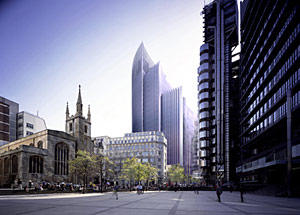

London now looks forward to “31 major new developments… all £100bn worth of them, including the 2012 Lea Valley Olympic Park.” That equates to “400,000 new homes, around 8m square feet of new offices (four Empire State Buildings’ worth),” as well as “so many secret, or simply obscure, developments” that the New London Architecture centre (aka NLA) was created at least partially to help make sense of it all.
Brief questions: where is all this material coming from? I know new earth’s crust is continually being formed near the core/mantle boundary, for instance, and that superplumes of volcanic matter form massive geological features such as the Ontong-Java undersea Plateau, but you can only build so much architecture before you start to carve quite deeply into the planet. So: where are the negative spaces of these building booms? For every skyscraper in Ürümqi, is there a corresponding hole, quarry, or mine being dug or deepened somewhere in Kazakhstan? Or Montana? The Canadian arctic?
Like the urban geology walks mentioned in a recent BLDGBLOG post, could you do a geophysical tour of the earth’s voids, where huge quantities of mineral reserves and raw metals have been excavated, to say: this was Shanghai? Here is the hole that was transformed into Beijing?
The empty flats of Berlin, the New Ring of Moscow, New London Architecture – all rearrangements, transformations of the void, ever-deepening holes as we strip-mine the face of the planet.
If you’ve ever wondered what the streets and buildings and monuments of the UK are constructed from, a good enough place to start is the BBC’s Walks with Rocks, where psychogeography meets paleontology meets continental drift. Paleo-psycho-ontogeography, perhaps. In any case, now you can learn the geological origins of paving stones, the density, formation pressures and tectonic ancestry of the architraves on that rockin’ bldg across the street from Boots.

For instance: ‘Looking at the foyer of Berkeley Square House we can see Norwegian igneous combined with Italian freshwater spring limestones. The adjacent Citroen and Rolls Royce showrooms tempt us with Tethyan limestone full of fossils. The Tethyan region was the seaway that lay to the South of the Eurasian Continent and to the North of Australia/India/Africa during the Late Paleozoic and Early Mesozoic periods’ – from Stop 7 on the Dover Street, W1, map.
While you’re at it, my televisual posts continue with British Isles: A Natural History on BBC One: ‘The series and inserts explore how over three billion years Britain has been boiled in lava, buried under tropical swamps and swept by desert sands. They show how it was crushed by enormous glaciers, released by warm winds, forested from north to south and how the influence of human life has dramatically changed the landscape.’ You can also ask what’s beneath your feet – no, it’s not sheepshit, it’s…
Then there are these audio recordings from the BBC’s new *Coast* show, which despite suffering from a rather alarming quantity of badly-accented historical reenactors offers one model for how to podcast a landscape.
Here’s a link to the first episode of the TV show, which, in combination with the second episode, traces out the following geography:

Finally, more Atlantis b.s. in the news, but I still think it’s cool: another tsunami theory, this one about Spartel Island (now submerged) in the Straits of Gibraltar:
As security culture intensifies and cameras are installed and walls are built and our cities become slowly fortified – Baghdad, for instance, as Dexter Filkins writes in tomorrow’s *NYTimes*, “seems a city transported from the Middle Ages: a scattering of high-walled fortresses, each protected by a group of armed men. The area between the forts is a lawless no man’s land, menaced by bandits and brigands” – I’m left wondering if perhaps Belfast – yes, Belfast, though maybe Derry (once the most televised city on earth due to the incredible extent of its police CCTV network) – could someday serve as a predictive future history for cities like London and New York – or, for that matter, Baghdad.

That coming urban secrecy and fortressed paranoia is, in fact, already marked in advance for future readers in a poem by Seamus Heaney:
‘O land of password, handgrip, wink and nod,
Of open minds as open as a trap,
Where tongues lie coiled, as under flames lie wicks,
Where half of us, as in a wooden horse
Were cabin’d and confined like wily Greeks,
Besieged within the siege, whispering morse.
(…)
This morning from a dewy motorway
I saw the new camp for the internees:
A bomb had left a crater of fresh clay
In the roadside, and over in the trees
Machine-gun posts defined a real stockade.
There was that white mist you get on a low ground
And it was déjà-vu, some film made
Of Stalag 17, a bad dream with no sound.
…We hug our little destiny again.’
(from ‘Whatever You Say Say Nothing’)
For those of you who also live in Philadelphia, you may have noticed that the intersection at 20th and Market Streets is perhaps the windiest such junction on the entire eastern seaboard. By some Luciferian inversion of urban feng shui, the empty lot on the NE corner there forms a system with the nearby railway, which forms a system with the god awful bldg on the NW corner, which works with that ridiculous overhanging outdoor lobby of the Philadelphia Stock Exchange, all of which works with the quasi-maritime climate of southeastern Pennsylvania to form a kind of standing tornado in front of FedEx-Kinko’s.
You can literally see plastic bags whirling in a vortex 30-feet in diameter, just whirling and whirling and then your clothes fly sideways and your umbrella pops inside-out if it’s raining.
Then I was reading last night in the new “Special Edition” of *Scientific American* (“Our Ever Changing Earth”) that “Tectonic events, such as the development of the Himalayas, may have influenced world climate.” (This is roughly 800,000 years ago).
But think about that: there’s the entire planet, and then this one little region starts to lift up. At first it’s just little hills, like the Cotswolds, and maybe you can hear the wind moan on lonely nights and the local birds use the updrafts to experiment with territorial expansion.
But the hills get bigger, slowly, every year. The wind patterns begin to change. You don’t even notice it at first. But seeds scatter further in thunderstorms, and forests grow in expanding rings. Flowers find themselves colonizing little plains and valleys miles and miles away from where they originated. (This could lead to the field of biogeography: or, deducing the tectonic landscape of nearby regions by the success & expansion rates of local wildflowers. In fact, I’m reminded here of an article I read about two years ago in *The Guardian*, that an Australian man began to notice strange flowers growing in his garden; it turned out that a drought on the other side of the country had led to dirt, seeds, and bits of soil being blown all over Australia. The result: in this man’s garden, strange flowers did grow…).
But the mountains continue to grow. Storms themselves grow in intensity, affecting weather elsewhere, hundreds of miles away. Now entire continental wind systems have changed; there’s a rain-shadow over some of the deeper gorges, and a desert begins to form. This affects regional temperature variation. Cyclical weather from the coast changes its distant land routes, moving further north or bending round the mountains and interweaving with weather from elsewhere. An island two thousand miles away now experiences harsher rainy seasons, as two previously unrelated storm systems merge and move toward it every November. This leads to heavy forestation – which leads, in a million years, to coal beds, and wars, and Halliburton…
But the mountains keep growing. Entire planetary atmospheric networks have been altering, year after year. Now a continent on the other side of the earth finds large, sea-going, migratory birds landing on its shores every winter.
Etc.
The point is that distant tectonic events produce microclimates, which in turn affect macroclimates, which in turn affect microclimates farther away.
Such as the intersection at 20th & Market, in Philadelphia. I suppose you could produce a wind-map of the Greater Philadelphia region, and here’s where we leave landscape and hit architecture: what buildings could be removed, starting fifty miles away, that would change the unmoving tornado of wind at 20th & Market? Moving closer – within ten miles – which walls or fences could be built just a foot higher – or lower – to augment the effect? Does a new housing development in Montgomery County make it easier or harder to walk across 20th & Market?
Moving closer, into the intersection itself, could you actually map-out the thermal vortices and architectural directions that shape the wind within the intersection, and then build special “wind mirrors,” or redirectional shields, controlled by a central computer, that, in certain positions, entirely negate, erase, eliminate, and deny the wind from forming in the first place?
You toggle the little wind mirrors until the wind disappears – and suddenly the intersection goes silent. The skirts of financial professionals flutter back to knee-height. Comb-overs stayed combed over. I stop grimacing.
Could you attach wind mirrors to every building in the city, producing an artificial microclimate specific to Philadelphia?
Could you do the same to New York City, and to Boston, and to Washington DC, and then arrange them all so that extremely high-powered, hurricane-like winds blow northeastward, destroying Halifax and grounding planes at London’s Heathrow?
The Wind Gun. Or: How to weaponize a landscape.
You could rig sailing contests. Neutralize rainstorms. Assist sunbathers perturbed by the hubris of a cloudy atmosphere.
Stay tuned for a similar idea, actually… Soon.
In what turns out to be an oddly inspiring article, we read about the green-roofing of New York City and Chicago.

Green-roofing – really just planting a garden on your roof – is – well, just read the article: “The carefully selected plants and soil – engineered to weigh only a fifth as much as typical dirt – help clean the air and absorb rain that would otherwise become storm-water runoff. And when many of them are clustered together, green roofs can reduce the urban heat island effect (densely populated cities tend to be hotter than surrounding areas because of the heat-trapping properties of tall buildings, asphalt and concrete).”
In other words, they’re anti-parking lots.
They’re the *ne plus* of the *ultra* for the world of urban car park management.
In any case, “‘Isolated green roofs are expensive insulation,’ Ms. Hoffman [executive director of Earth Pledge] said. ‘But when you have a whole community of green roofs, it changes the microclimate of the area and reduces demand for energy.'”
Microclimates!
Because of such efforts elsewhere, not only does Chicago’s City Hall have a green roof – the first municipal building in the city to do so – but in Long Island City roof gardeners are now at work: “A matrix of 1,500 planters will have 20 different species of plants intended to show off their red, yellow and green colors, visible from the Queensboro Bridge when in full bloom.” After all, “Long Island City has 667 acres of empty flat-roof surfaces suitable for vegetation, an area more than three-quarters the size of Central Park.”
So what do we have to look forward to?
Landscape design involving multiple levels of altitude, distributed across multiple clusters of buildings. The hanging gardens of Long Island City. Golf courses parring-off above the roofs of the Meat Packing District. Color-coded blooming cycles visible from space. In 2009, a fierce rooftop landscapers’ rivalry breaks out: on the one hand you have a descendent of Frederick Law Olmsted; on the other, an upstart firm of BLDGBLOG readers. The main problem right away, of course, is that there’s not nearly enough tension in that rivalry, but hey: war is declared. Ever more extravagant gardens are planned and planted; rope bridges and lightshows (special UV lights that help the plants to photosynthesize at night: leading to the question: if cinemas showed movies using UV light, could you grow plants by, say, *Invasion of the Body Snatchers*? could you grow a tree that has *Logan’s Run* literally burned into its leaf-structure and canopy?) and hammocks and rare hybridized clone-flowers growing in baroque-to-minimal patterns all over the city. The Oak and Maple district, where leaf tourists come every October to see spectacular colors. The Orchards of Gramercy Park; Gramercy Apples. You can follow lines of yellow flowers planted along old historic walking paths; lines of red flowers signify walks of military interest. Blue flowers are for cultural history. Massive clouds of moths are released into the city by the Olmsted descendent, cross-pollinating everything in sight; films are projected upon them from the windows of high-rises.
New hybrid roses bloom in the shadows of glass factories given over to sunflowers and lavender. At night you can smell the city’s strange perfumes…
Well, I’m losing interest in this image, but you get the picture.

On a site that is rather amazingly drenched with typos, misspellings, and other grammatical errors, we found this call for developing a car park picturesque, or “landscaped tarmac for leisure” – surely the post-human car park could be retroverted for this…?
Meanwhile, for all you Maunsell Towers fans –


– there’s the Texas tower: 75 miles east of New Jersey, though now collapsed into the sea, it was “intended to provide advance warning of enemy air attacks,” as “part of the Distant Early Warning system (DEW line) encircling the United States and Canada.” It collapsed into the sea, however, and killed everyone on board. Archigram meets James Cameron’s Abyss.


So I’m writing this at the beginning of a month-long James Bond marathon on AMC-TV, and am thinking, in this context, how all of Bond’s villains seem really to be renegade techno-architectural contractors of some sort: you have that fake volcano movie, the hollow high-tech island of Dr. No, that stupid ice-city of the last (please!) Pierce Brosnan Bond, and what else was there – oh, Moonraker –


– in a particularly aerospatial moment of villainous ambition. In any case, then it occurred to me: that’s exactly what Osama bin Laden is/was – he’s a contractor. He built highways.
Plus ça change: he’s an ultra-rightwing Bond villain.